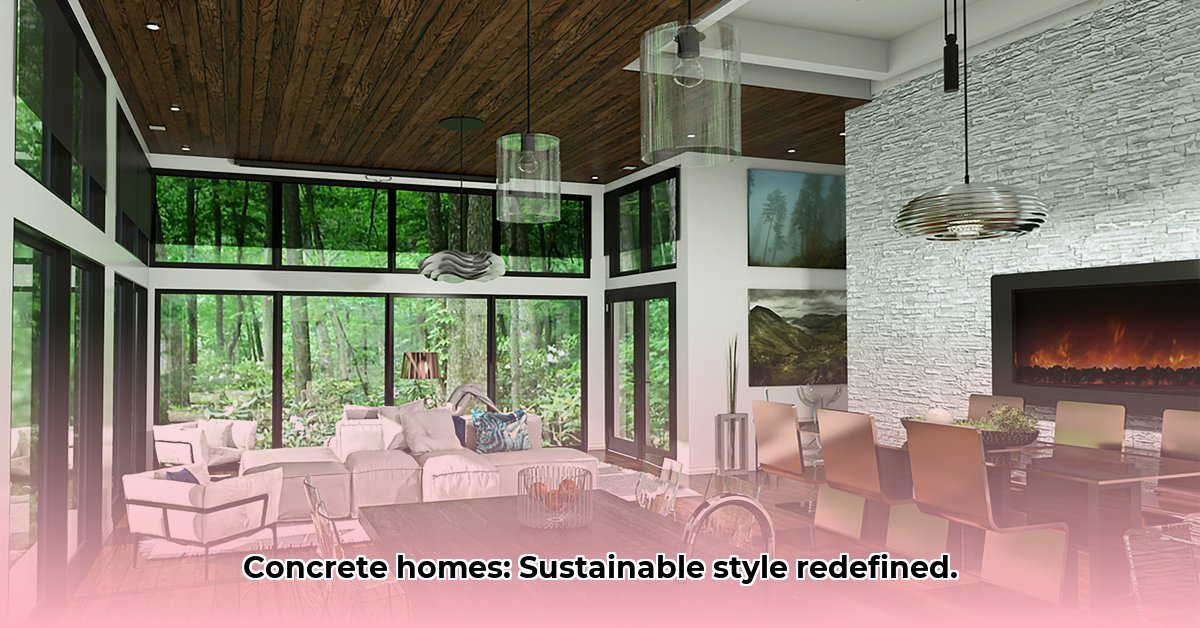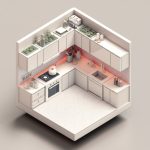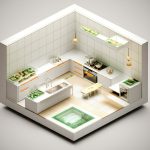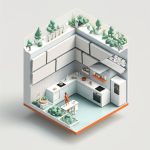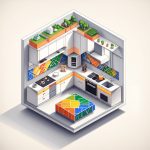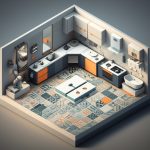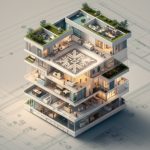Thinking about building a home? Concrete might surprise you! It’s not just for boring, gray buildings anymore. Modern concrete homes are sleek, sustainable, and surprisingly versatile. This guide dives into the world of stylish concrete houses, showing you how they’re designed, built, and adapted to different climates. We’ll cover everything from the latest design trends and eco-friendly building techniques to the costs and how to keep your concrete home looking great for years to come. Whether you’re a builder or just curious, get ready to see how concrete can create a stunning and environmentally responsible home. For more modern house design ideas, check out [this resource](https://www.wavesold.com/modern-house-design-ideas/).
Modern Concrete House Designs: A Sustainable and Stylish Revolution
Modern concrete homes are gaining popularity because they are remarkable, durable, and surprisingly eco-conscious! This guide explores the exciting world of contemporary concrete architecture, from cutting-edge design trends to sustainability in construction practices. It is an adventure into innovative and modern home building.
Design Aesthetics: Beyond the Typical Gray Building – Concrete House Exterior Ideas
Modern concrete houses are anything but uninteresting. Designers are pushing boundaries, delivering both eye-catching and functional spaces. Explore minimalist, brutalist, and biophilic designs and their individual aesthetics.
- Minimalism and Concrete: Clean lines, open floor plans, and neutral color palettes define this style. Light streams in, accenting the building’s shape and furnishings. Simplicity, elegance, and letting the concrete texture shine are key.
- Brutalism Reimagined: Raw, exposed concrete creates dramatic architectural features and a powerful structural connection. This style suits those who adore honest, unadorned design and robust forms. Often features geometric, monolithic forms that showcase the inherent texture and color variations of the concrete itself.
- Biophilic Harmony: Seamlessly integrates nature into the design, with lush indoor gardens and natural elements softening the concrete. This architectural design creates a peaceful, balanced atmosphere that invites the outdoors inside.
- Prefabrication: Pre-cast concrete panels or entire modules are assembled quickly on-site, reducing construction time, waste, and costs. It is like building with robust, visually appealing LEGOs. Prefabrication methods can reduce construction time by up to 40 percent.
Construction Techniques: Methods for Building Your Concrete Dream – Concrete Wall Construction
Several ingenious methods bring modern concrete home designs to life, each with its advantages and disadvantages based on budget, design preferences, and site features.
1. Insulated Concrete Forms (ICF): Hollow blocks filled with reinforced concrete on site improve construction speed and energy efficiency. These forms stay in place, providing continuous insulation.
2. Poured Concrete: Liquid concrete poured into custom-built forms allows complex shapes but is labor-intensive. This technique offers design flexibility and structural integrity.
3. Concrete Block (CMU): Concrete masonry units are versatile and affordable but may need extra insulation. Reinforcing steel and grout are typically added for increased strength.
4. Precast Concrete: Concrete elements are cast off-site and then transported to the construction site for assembly. This offers precise control over quality and accelerates construction timelines.
Consider this comparison:
| Construction Method | Pros | Cons |
|---|---|---|
| Insulated Concrete Forms (ICF) | Better insulation, faster build times, energy-efficient, sound dampening | Higher initial costs, less design flexibility compared to poured concrete, requires skilled installation |
| Poured Concrete | Exceptional design freedom, robust and durable, excellent thermal mass | Labor-intensive, slower build times, usually more expensive, requires careful formwork |
| Concrete Block | Cost-effective, readily available, versatile, good fire resistance | May require significant additional insulation, less design flexibility, more joints lead to potential air leakage |
| Precast Concrete | High quality control, fast erection, suitable for repetitive designs | Transportation costs can be high, requires careful planning and lifting equipment, limited on-site adjustments |
Sustainability: Concrete’s “Green” Features – Sustainable Home Design
Modern concrete homes can be environmentally friendly with careful consideration. The key is to optimize the concrete mix and design for energy efficiency.
- Eco-Friendly Concrete Mixes: These help minimize the need for new resources and lower the carbon footprint. Modern mixes use recycled materials, reducing environmental impact. Supplementary cementitious materials (SCMs) like fly ash, slag, and silica fume can replace a portion of the Portland cement, significantly lowering the embodied carbon.
- Passive Design Methods: Maximize natural light and ventilation while improving energy efficiency and lowering environmental impact. Smart design features are essential components. Orienting the building to maximize solar gain in winter and minimize it in summer can dramatically reduce energy consumption.
- Recycled Materials: Reclaimed materials, like recycled steel rebar or aggregate, reduce environmental impact. Reducing waste from construction and demolition is a key factor in sustainable building. Using demolition aggregate as a base for concrete slabs is an excellent example.
- Thermal Mass: Concrete’s high thermal mass helps regulate indoor temperatures, reducing the need for heating and cooling. This is especially effective in climates with large temperature swings.
Regional Adaptations: Concrete’s Adaptation to Global Climates
A well-designed concrete home considers its environment, adapting approaches for different climates like Mediterranean, tropical, and northern regions.
- Mediterranean Climates: Thick concrete walls offer superior insulation against summer heat, maintaining cool interiors. Small windows and light-colored facades further reduce heat gain. Courtyards and shaded outdoor spaces are common.
- Tropical Climates: Ventilation and shading are crucial; overhangs protect against sunlight, and strategically placed windows and openings encourage airflow. Using light-colored concrete can also help reflect sunlight and reduce heat absorption.
- Northern Climates: Insulation is essential to maintain comfortable temperatures during harsh winters. Using ICFs or adding external insulation can significantly improve energy efficiency. South-facing windows can capture solar heat during the day.
- Desert Climates: Concrete’s thermal mass helps moderate temperature fluctuations. Earth sheltering, where the home is partially or fully buried, provides excellent insulation. Water harvesting systems can also be integrated into the design.
Cost and Maintenance: Investment and Long-Term Benefits – Budget Friendly Housing
Building a concrete house involves costs, but the long-term benefits often outweigh expenses.
- Initial Costs: Can be higher than traditional wood-framed homes, depending on the design complexity and construction method. Elaborate designs and specialized finishes will increase costs.
- Long-Term Value: Durable, pest and fire-resistant, minimal upkeep translates to long-term savings. This makes it an investment designed to last for generations. Concrete homes also tend to have lower insurance premiums due to their durability.
- Upkeep: Regular inspections and minor repairs can keep a concrete home in good condition. Sealing the concrete surfaces can protect against water damage and staining.
- Life Cycle Costs: Considering the entire life cycle of the building, including construction, operation, maintenance, and eventual demolition, can reveal the true cost-effectiveness of concrete homes.
Future Outlook: The Horizon of Concrete Housing – Modern Building Materials
Modern concrete home design is continuously evolving with innovations in construction methods and materials. It’s expected to offer versatility and an array of design freedom. Is the future of home design truly leaning towards sustainable and long-lasting concrete structures?
- 3D-Printed Concrete: This technology has the potential to revolutionize construction by allowing for faster, more efficient, and more complex designs. 3D printing can also reduce waste by precisely depositing material where it’s needed.
- Self-Healing Concrete: This innovative material incorporates bacteria that can repair cracks in the concrete, extending its lifespan and reducing maintenance.
- Smart Concrete: Incorporating sensors into the concrete allows for real-time monitoring of structural health, temperature, and other parameters. This data can be used to optimize energy efficiency and predict maintenance needs.
- Translucent Concrete: Embedded optical fibers allow light to pass through the concrete, creating visually stunning effects and reducing the need for artificial lighting.
How to Choose Sustainable Concrete Mixes for Eco-Friendly Home Construction
Key Takeaways:
- Supplementary cementitious materials (SCMs) like fly ash and slag significantly reduce a concrete’s carbon footprint.
- Recycled aggregates further enhance sustainability and reduce reliance on virgin materials.
- The water-to-cement ratio is a crucial factor in concrete strength and durability; optimizing this ratio reduces cement usage.
- The environmental impact depends heavily on the specific mix design and sourcing of materials.
Design Advancements in Sustainable Concrete Homes
Contemporary concrete homes offer remarkable design versatility. From minimalist aesthetics to biophilic designs, these homes seamlessly blend indoor and outdoor spaces. Prefabricated concrete systems streamline construction, while natural elements add warmth.
Construction Nuances: Reviewing Your Alternatives
Several techniques exist for building with sustainable concrete. Insulated Concrete Forms (ICF) provide improved insulation and energy efficiency. Poured concrete allows design flexibility, while concrete block construction is cheap. Choices depend on budget, desired aesthetic, and site conditions.
Insulated Concrete Forms (ICF)
- Pros: Excellent insulation, energy efficiency, fast construction, superior soundproofing.
- Cons: High initial material cost, potential thermal bridging if not properly installed, requires specialized skills.
Poured Concrete
- Pros: Design flexibility, durability, strength, seamless integration with complex architectural features.
- **Cons
- White On White Kitchen Backsplash: Is It Timeless? - November 20, 2025
- Backsplash Colors for White Cabinets: Find Your Perfect Match - November 19, 2025
- Backsplash Ideas for White Cabinets: Find Your Perfect Style - November 18, 2025
